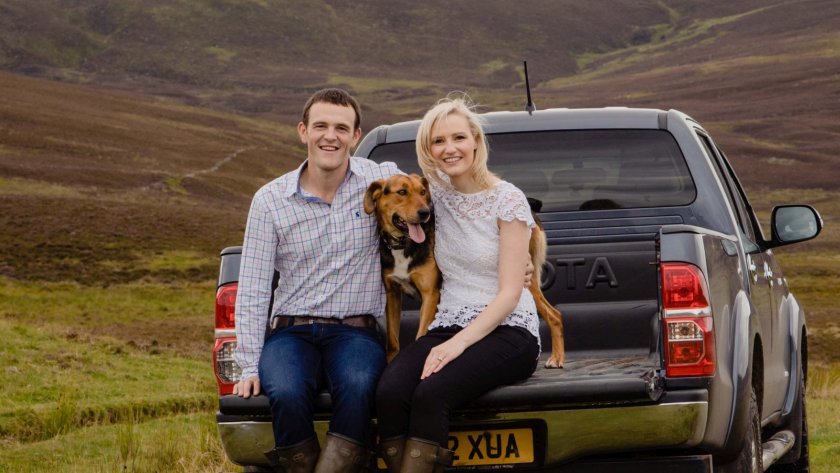
Having the time to effectively use the information gathered from weighing cattle can be a challenge for farmers, but experts say it can make the difference to profits and reducing emissions.
Trials are underway with two suckler beef producers as part of the Farming for a Better Climate (FFBC) project, run by SAC Consulting to support farmers to introduce different approaches.
The aim is to see how automating data collection at regular weighing times can help them to make informed decisions around breeding, nutrition and finishing dates to improve efficiency.
This weight data can identify the most efficient bulls to produce finishing cattle, for example, or to look at cow efficiency and at what percentage of body weight the cows are weaning.
Andrew Houstoun, of Glenkilrie, farms 170 Limousin and Angus cross cows over 1,000ha in the Perthshire hills, alongside 1,100 breeding ewes and 70 red deer hinds.
All spring calving, he sells the majority of the calves store, finishing some for the meat box business, Glenkilrie Larder, which he runs with his wife Lauren.
A key focus for him is to reduce cow size to help improve efficiency in the herd and better regulate his costs.
“I was very keen to get involved with this project as we have recorded weights for a long time but never really made good use of the data," Andrew said.
"There’s no doubt that data collection and analysis could make a huge difference to our stock management and selection, and this was a great opportunity to take it to the next level.”
At the start of the trial, they were using a mix of paper-based and manual input record-keeping, but they didn’t have the technology to automatically collect it.
Andrew, who doesn’t currently use electronic (EID) tags, invested in a Shearwell handheld stock recorder which links to a Tru-test xr5000 weigh head on the weigh scale to automatically record into Shearwell Farmwork software.
As a further comparison point for the project, he is also using Agriwebb software which allows weights to be recorded at the crush in the same manner, this time through an android tablet connected to the same weigh head.
The technology can be relatively low cost and easy to use, and when set up properly provides real benefits, says Lorna Macpherson, who is a consultant at SAC Consulting, part of Scotland’s Rural College (SRUC).
“Weighing cattle is a time-consuming job, and not everyone is set up to do this," she explained.
"Even those who do weigh cattle regularly don’t always have the technology to automatically capture the data or the time to analyse it, but as we’re seeing the right set up and technology can be a worthwhile investment.
"As well as making the process a lot simpler, collecting weight data on farm is hugely valuable for guiding future breeding decisions that improve the efficiency of beef production and making the most of what you’re doing on the farm.”
Although different systems, farmers undertaking the project have similar goals around efficiency. Iain Wilkinson, at Balgay Farm near Inchture in Perthshire, farms 1,000 acres under a share farming agreement.
As well as 200 Hereford and Shorthorn Cattle, both pedigree and commercial co-owned in the share agreements, he runs 450 Mules ewes of his own.
Iain uses low frequency EID tags and, ahead of starting the trial, invested in a Tru-test S3 weigh scale indicator which automatically records animal weights into his Breedr app.
Fixed to the crush, a simple press of the button at the start of each session collects the data.
All livestock is finished utilising the beans, grain and forage grown on the farm, with the aim of buying in as little extra resources as possible.
A key area of interest for him, therefore, is how he can improve the diet formulation to improve performance. By weighing monthly, he sees where he can adjust feed at regular intervals for best results.
Ruminant nutritionist Lorna Shaw, who is also running the trials, notes that the greatest barrier to the widespread uptake of fully automated data collection is the reluctance to invest in EID tagging.
This is until Scottish government can confirm what will be required (high frequency vs low frequency) going forward, as this would make a difference to what equipment is required.
However, she says the trials across both farms are showing some emerging patterns, and that the advantages of using the data to improve the performance of the cattle helps the bottom line as well as the environmental credentials of the herd.
Lorna Shaw said: “Gain for profit and the environment are closely linked. Improving feed efficiency and earlier slaughter dates can reduce overall lifetime emissions as well as improve margins enhanced by less feed, labour and bedding costs.
"By improving the process of data capture and using the information wisely, farmers can benefit on both fronts, and it will be easier for them to take advantage of future payment schemes that reward environmental measures.”
